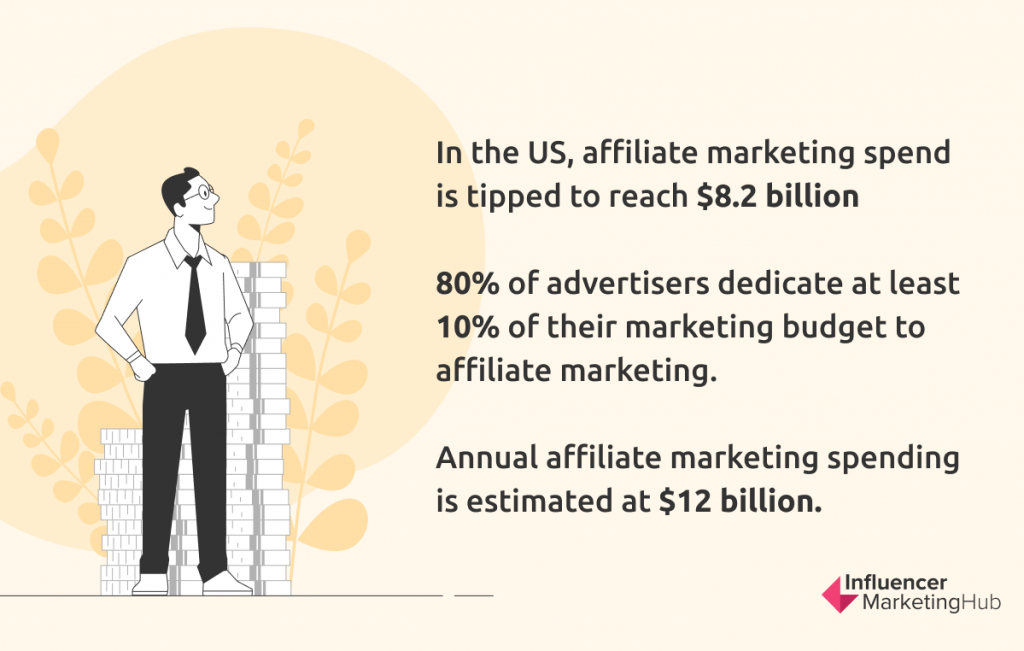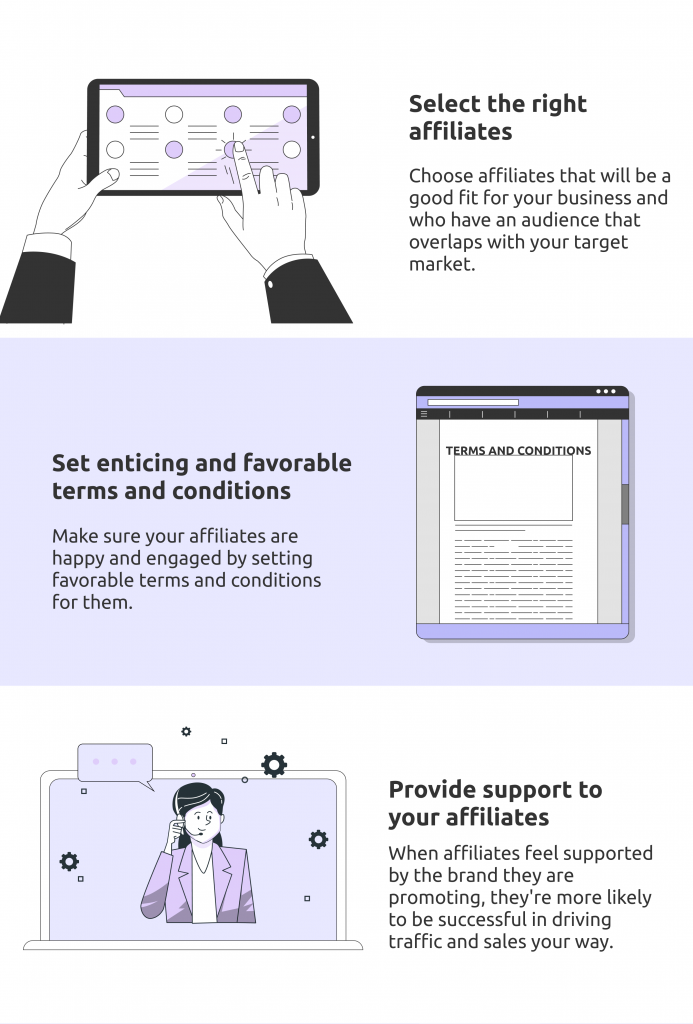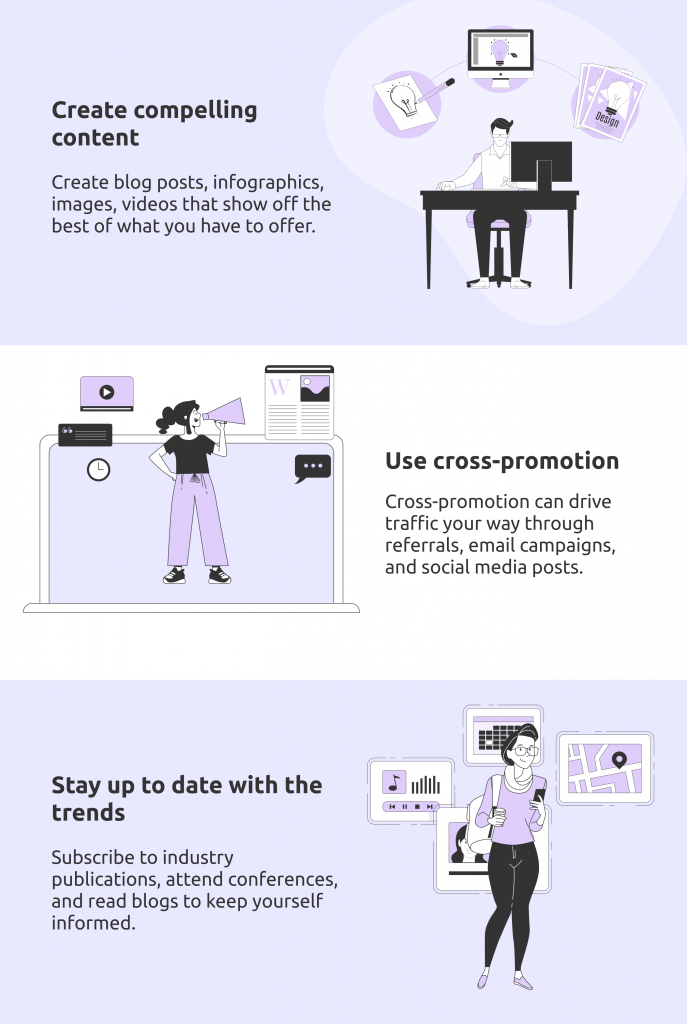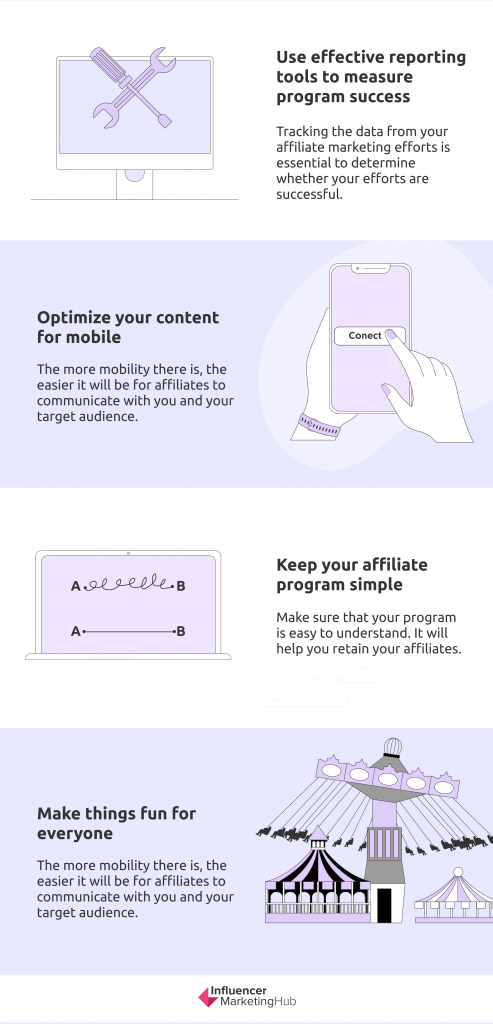We all know that practice makes perfect. When it comes to affiliate marketing, determining the most effective approach can be tough because there are so many methods and techniques available. What works best for one business might not work at all for another.
When done correctly, affiliate marketing can be a very effective way to grow your business. However, it's important to keep in mind that there are some best practices that will help you get the most out of your marketing efforts and ensure success. In this article, we'll take a look at thirteen of the best practices that can make a big impact on your affiliate marketing programs.
13 Best Practices for Affiliate Marketing:
- 1) Develop a plan
- 2) Establish clear goals and objectives
- 3) Understand your customers
- 4) Select the right affiliates
- 5) Set enticing and favorable terms and conditions
- 6) Provide support to your affiliates
- 7) Create compelling content
- 8) Use cross-promotion
- 9) Stay up to date with the trends
- 10) Use effective reporting tools to measure program success
- 11) Optimize your content for mobile
- 12) Keep your affiliate program simple
- 13) Make things fun for everyone
What Is Affiliate Marketing?
Affiliate marketing is a type of performance-based marketing in which a business rewards one or more affiliates for each visitor or customer brought by the affiliate's own marketing efforts.
How can you get started with affiliate marketing? Before diving into affiliate marketing, it's important to understand how it works and how it can benefit your business. Essentially, affiliate marketing is a partnership between a business and an affiliate (or affiliates) in which the affiliates promote the business' products or services in exchange for earning a sales commission.
Types of Affiliate Marketing Programs
There are several types of affiliate marketing programs. Here are the most common ones:
- Pay Per Click (PPC): In this type of program, the advertiser pays the affiliate each time a visitor clicks on an ad or banner. It's common for PPC programs to offer a flat fee or a commission on each sale.
- Pay Per Lead (PPL): In this type of program, the affiliate is paid for each lead generated through their marketing efforts. This could include signing up for a newsletter, filling out a survey, or registering for a webinar.
- Pay Per Sale (PPS): In this type of program, the affiliate is paid a commission on each sale generated through their marketing efforts. This type of program is the most common and offers the best potential for earning a commission.
Now that you know what affiliate marketing is and its most common programs, it's time to learn the best practices that will help you and your business get the most out of this marketing strategy.
1) Develop a plan
Having a well-laid out plan for your business will help you understand what needs to be done and how often. KPIs (key performance indicators) give insight into the success of each part in terms of conversion rates or return on investment (ROI)—these can't happen without an organized strategy.
A good roadmap will help you understand what you need to do so that your efforts won’t be wasted on low conversion rates or even worse—zero ROI. Check your strategy on a regular basis to ensure you're on track. You'll be able to get an idea of whether anything needs to change for the next quarter, and you can learn how everything currently stands.
2) Establish clear goals and objectives
Affiliate marketing can be a great way to grow your business, but only if it is done with clear goals and objectives in mind. Once you define what they are, you can start to establish KPIs that will help you regularly measure and track your progress.
Before you start building an affiliate program, you need to know what you want to achieve with it. Are you looking to generate leads, drive sales, increase brand awareness, or build better relationships with your customers and partners? Answering these questions will help you determine what type of affiliate program to join, what products or services to promote, and how to best reach your target customers.
3) Understand your customers
Your marketing efforts should be aimed at providing value to your customers. The way you market your products and brand, as well as how you learn about your customers, will greatly influence the success of your affiliate campaigns.
Knowing your customers is vital to all marketing practices and affiliate marketing is no exception. Why? Because you can't create effective campaigns without knowing your target market and how they experience your brand.
Your customers are unique, so it's important that you treat them as such. Understanding their preferences and interests isn't enough. Determining their pain points and providing solutions are the ways you can set yourself apart from the competition. When you know your customers inside and out, it's much easier to create more targeted and effective affiliate marketing campaigns.
4) Select the right affiliates
Having a plan and knowing your customers aren't enough when it comes to affiliate marketing. Another best practice is to carefully select the right affiliates.
Not all affiliates are created equal. When selecting partners for your affiliate marketing program, you need to carefully consider their audience, content, and overall brand alignment. Choose affiliates that will be a good fit for your business and who have an audience that overlaps with your target market.
Make Your Users Your Affiliates
What better way to achieve your business goals and objectives with affiliate marketing than to have your current users promote your products and services for you? This practice is a great way to increase brand awareness and build customer loyalty.
User-generated content (UGC) is one of the most effective types of marketing, as it's trusted more than traditional advertising. When customers see their peers talking about your brand, they're more likely to be interested in what you have to offer.
There are a few ways you can encourage your customers to generate UGC, such as offering discounts or coupons, running social media contests, or simply asking them to leave reviews.
Connect With Influencers
One of the best practices for affiliate marketing is to connect with influencers. An influencer is someone who has a large following on social media or their own blog and can promote your products or services to their audience.
When done correctly, influencer marketing can be an extremely effective way to reach a larger audience and generate more leads and sales. But it's important to make sure that you partner with the right influencers.
One of the affiliate marketing trends is to work with influencers who have a smaller audience because they're not as overwhelmed with advertising offers and are more likely to engage with your brand.
Review Your Affiliate List
It's also important that you periodically review your affiliate program to ensure that the affiliates you've chosen are still working well for you. If your affiliates are just promoting products or services without providing any value, then it's time to reconsider whether they're a good fit for your program.
5) Set enticing and favorable terms and conditions
Another important practice for affiliate marketing is making sure your affiliates are happy and engaged by setting favorable terms and conditions for them. Without this basic assumption in place, it will become difficult for them—as well as yourself—to enjoy a positive experience together with a fruitful partnership.
You see, ROI in affiliate marketing takes time. Your affiliates can get discouraged if their efforts don’t produce good results right away. But if you set terms and conditions that are fair, give them room to grow, and effectively communicate with them. They're more likely to stick around for the long haul.
Here are a few things to consider when setting terms and conditions for your affiliate program:
- Commission rates: Fair and enticing commission rates will help attract more affiliates to your program.
- Product or service offering: Make sure your affiliates are promoting products and services that they feel comfortable with and fit well with their audience.
- Mandatory affiliate marketing tools: If you're requiring your affiliates to use specific marketing tools, make sure they're easy to use, and provide adequate support.
- Affiliate reporting: Make sure your affiliates have access to detailed performance reports, so they can track their progress and successes.
- Cookie duration: The longer the cookie duration, the better. This gives your affiliates a chance to earn commissions on sales that are made long after they've referred someone to you.
- Performance incentives: On top of commission from sales, you can provide incentives for your best-performing affiliates, such as exclusive offers and early access to new products.
- Payment terms: Be clear about when and how your affiliates will get paid. Affiliates need to know that they'll receive their commissions in a timely manner.
- Exclusivity: You may want to consider making your program exclusive to only a handful of affiliates. This can help improve the quality of your affiliate relationships.
- Length of agreement: The length of your affiliate agreement will also be important. You'll want to set a reasonable time frame for the relationship so that both parties can commit without feeling like they're locked in.
There are plenty of other things to think about when setting up your affiliate program, but these are good places to start. Keep in mind that you may need to adjust your terms and conditions as your affiliate marketing program evolves.
6) Provide support to your affiliates
A great practice with your affiliates is to treat them as partners. When they feel supported by the brand they are promoting, they're more likely to stick around and be successful in driving traffic and sales your way.
You can provide affiliates with resources like banner ads, email templates, and even product images to help them promote your products or services on their site or in their social media posts. You can also give them access to exclusive deals and offers that will incentivize their audience to convert.
And, of course, you should always be available to answer any questions they have or provide assistance when needed. By providing top-notch support, you'll foster a better relationship with your affiliates and increase the chances of success for both parties.
7) Create compelling content
Another best practice for affiliate marketing is to create compelling content that will encourage your affiliates to promote your products or services. This means creating things like blog posts, infographics, images, videos, and more that show off the best of what you have to offer.
When your affiliates have great content to share with their audience, they're more likely to do so. They don't necessarily want to share something that isn't genuinely useful or interesting to their audience. If they do, it will reflect poorly on both you and your affiliates, and it could even lead to them losing followers.
8) Use cross-promotion
A quick and effective way to increase the exposure of your affiliate program and attract new affiliates is through cross-promotion. While it can be seen as a form of competition, it really isn't. The purpose behind this is to promote brands with similar audiences that are not in direct competition. This helps generate leads for your business while boosting sales at other places where you advertise their products or services too.
Cross-promotion can drive traffic your way through referrals, email campaigns, and social media posts on Facebook, Instagram, or TikTok. You can also guest blog for other sites in your industry, which will help you reach a new audience while also getting your name out there as an authority in your field.
This practice is mutually beneficial and is a great way to get started with affiliate marketing without putting all your eggs in one basket. By using cross-promotion, you can reach a wider audience and increase your chances of making sales.
9) Stay up to date with the trends
The affiliate marketing landscape is constantly changing, so it’s important to stay up to date with the latest trends and best practices. Subscribe to industry publications, attend conferences, and read blogs to keep yourself informed.
For example, if a new social media platform emerges that could be beneficial to the promotion of your products or services, you can quickly add it to your marketing mix. This brings new opportunities for your affiliate program and helps you reach a larger audience.
It’s also important to keep an eye on the competition and see what they’re doing with their affiliate programs. If they’re successful in using a certain type of content or promotional method, you can learn from their example and adapt it to your own business.
10) Use effective reporting tools to measure program success
Tracking the data from your affiliate marketing efforts is essential to determine whether your efforts are successful or not. Tools such as Google Analytics can help you measure things like website traffic, conversions, and sales. This information will help you better understand how your affiliates are performing and what changes or adjustments need to be made.
Try different approaches and analyze the results to see what works best for your business. Regularly review your metrics and make changes to improve your results.
11) Optimize your content for mobile
Affiliate marketing should be mobile-friendly. As the number and speed at which people use their smartphones increase, so too must companies' outputs be tailored to match these changes in behavior if they want affiliate marketing to work effectively.
If you are working with a younger generation of reps, it is important for each step in your business to be mobile-friendly. The more mobility there is, the easier it will be for affiliates to communicate with you and your target audience.
12) Keep your affiliate program simple
One of the best things you can do for your affiliate marketing program is to keep it simple. The last thing you want is for your affiliates to get confused or overwhelmed by the process. By keeping things straightforward, you’ll increase the likelihood that they’ll stick with it and continue promoting your products or services.
Remember, affiliates may not be exclusive to your company. They may also be promoting other businesses at the same time. Make sure that your program is easy to understand. It will help you retain your affiliates.
13) Make things fun for everyone
Even if you have the best affiliate program in the world, it won’t matter if your affiliates are not having fun while working hard to earn themselves some money.
Aside from incentives, you can make things fun for affiliates by hosting meetups and contests. You can also give out free merchandise, not just as branding tools but also as rewards for meeting certain milestones. These will keep them motivated and help to increase their productivity.
Final Thoughts
Affiliate marketing can be an extremely effective way to grow your business. You have the potential to reach more people who are interested in what you have to offer. By following these best practices, you can set yourself up for success and build strong relationships with your affiliates.
Keep in mind that affiliate marketing is ever-evolving, so you should always be on the lookout for new opportunities and trends. Stay up to date with changes in technology and consumer behavior to make sure that your affiliate marketing efforts are as effective as possible.
Now that you know some of the best practices for affiliate marketing, it's time to put them into action and start seeing results. Remember, Rome wasn't built in a day. It takes time, effort, and consistency to see success. So don't get discouraged if you don't see results right away. Just keep working at it and you'll eventually start to see the fruits of your labor.







